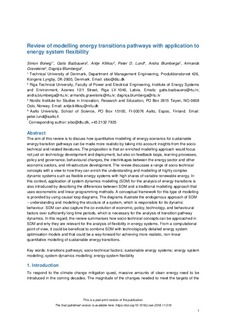| dc.contributor.author | Bolwig, Simon | |
| dc.contributor.author | Bazbauers, Gatis | |
| dc.contributor.author | Klitkou, Antje | |
| dc.contributor.author | Lund, Peter D. | |
| dc.contributor.author | Blumberga, Andra | |
| dc.contributor.author | Gravelsinš, Armands | |
| dc.contributor.author | Blumberga, Dagnija | |
| dc.date.accessioned | 2018-12-19T10:25:42Z | |
| dc.date.available | 2018-12-19T10:25:42Z | |
| dc.date.created | 2018-12-05T09:05:26Z | |
| dc.date.issued | 2018 | |
| dc.identifier.citation | Renewable & Sustainable Energy Reviews. 2018, 101 (March), 440-452. | nb_NO |
| dc.identifier.issn | 1364-0321 | |
| dc.identifier.uri | http://hdl.handle.net/11250/2578281 | |
| dc.description.abstract | The aim of this review is to discuss how quantitative modelling of energy scenarios for sustainable energy transition pathways can be made more realistic by taking into account insights from the socio-technical and related literatures. The proposition is that an enriched modelling approach would focus not just on technology development and deployment, but also on feedback loops, learning processes, policy and governance, behavioural changes, the interlinkages between the energy sector and other economic sectors, and infrastructure development. The review discusses a range of socio-technical concepts with a view to how they can enrich the understanding and modelling of highly complex dynamic systems such as flexible energy systems with high shares of variable renewable energy. In this context, application of system dynamics modelling (SDM) for the analysis of energy transitions is also introduced by describing the differences between SDM and a traditional modelling approach that uses econometric and linear programming methods. A conceptual framework for this type of modelling is provided by using causal loop diagrams. The diagrams illustrate the endogenous approach of SDM – understanding and modelling the structure of a system, which is responsible for its dynamic behaviour. SDM can also capture the co-evolution of economic, policy, technology, and behavioural factors over sufficiently long time periods, which is necessary for the analysis of transition pathway dynamics. In this regard, the review summarises how socio-technical concepts can be approached in SDM and why they are relevant for the analysis of flexibility in energy systems. From a computational point of view, it could be beneficial to combine SDM with technologically detailed energy system optimization models and that could be a way forward for achieving more realistic, non-linear quantitative modelling of sustainable energy transitions. | nb_NO |
| dc.language.iso | eng | nb_NO |
| dc.relation.uri | http://www.nordicenergy.org/flagship/flex4res/ | |
| dc.subject | Transitions pathways | nb_NO |
| dc.subject | Socio-technical factors | nb_NO |
| dc.subject | Sustainable energy systems | nb_NO |
| dc.subject | Energy system modelling | nb_NO |
| dc.subject | System dynamics modelling | nb_NO |
| dc.subject | Energy system flexibility | nb_NO |
| dc.title | Review of modelling energy transitions pathways with application to energy system flexibility | nb_NO |
| dc.type | Journal article | nb_NO |
| dc.type | Peer reviewed | nb_NO |
| dc.description.version | acceptedVersion | nb_NO |
| dc.subject.nsi | VDP::Samfunnsvitenskap: 200 | nb_NO |
| dc.subject.nsi | VDP::Social sciences: 200 | nb_NO |
| dc.source.pagenumber | 440-452 | nb_NO |
| dc.source.volume | 101 | nb_NO |
| dc.source.journal | Renewable & Sustainable Energy Reviews | nb_NO |
| dc.source.issue | March | nb_NO |
| dc.identifier.doi | 10.1016/j.rser.2018.11.019 | |
| dc.identifier.cristin | 1639269 | |
| dc.relation.project | Nordisk Energiforskning: 76084 | nb_NO |
| cristin.unitcode | 7463,0,0,0 | |
| cristin.unitname | NIFU Nordisk institutt for studier av innovasjon, forskning og utdanning | |
| cristin.ispublished | true | |
| cristin.fulltext | postprint | |
| cristin.qualitycode | 1 | |
